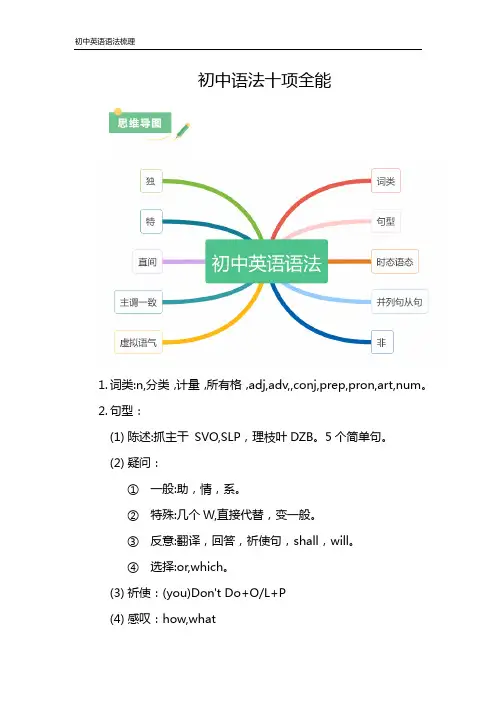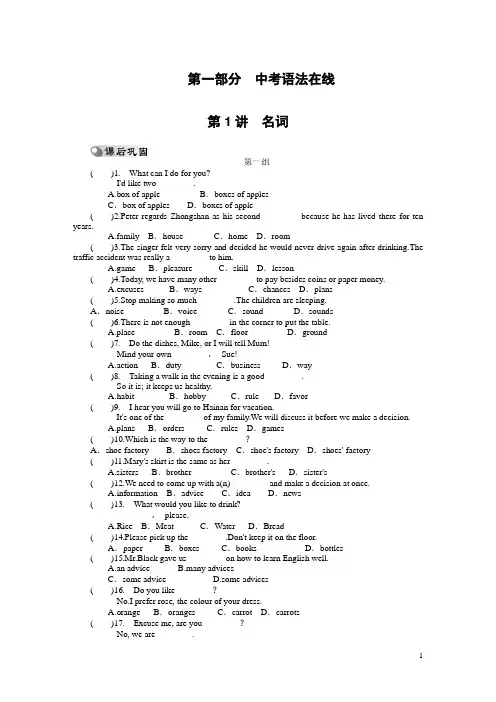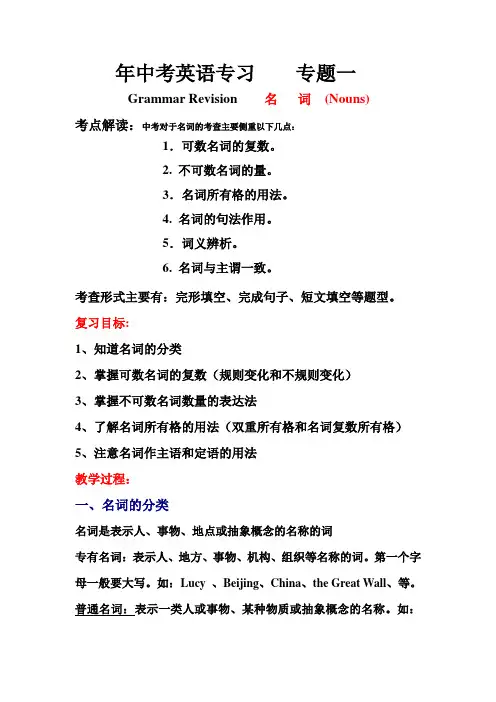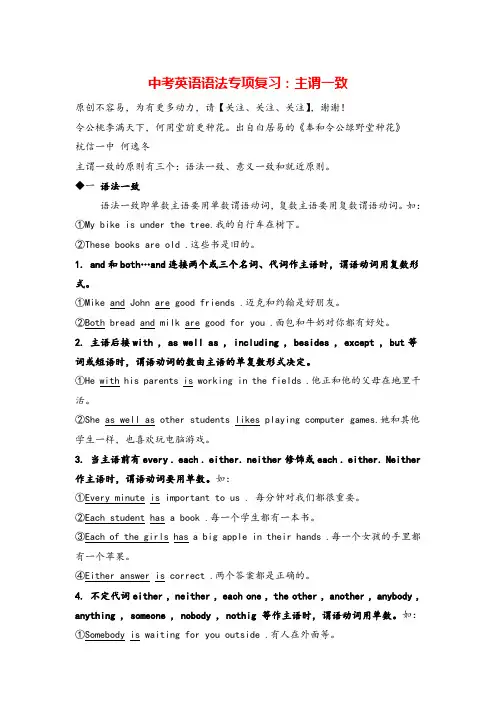人教版中考英语语法专项复习
- 格式:ppt
- 大小:402.00 KB
- 文档页数:2

初中语法十项全能1.词类:n,分类,计量,所有格,adj,adv,,conj,prep,pron,art,num。
2.句型:(1)陈述:抓主干SVO,SLP,理枝叶DZB。
5个简单句。
(2)疑问:①一般:助,情,系。
②特殊:几个W,直接代替,变一般。
③反意:翻译,回答,祈使句,shall,will。
④选择:or,which。
(3)祈使:(you)Don't Do+O/L+P(4)感叹:how,what3.时态:定义,顺序。
现、过、将、过将;一,进,完,完进。
6种形式、否定。
语态:be done /be being done /have been done。
4.并列句:平2,转3,选3,因3。
从句:n,SOPT,两种情况,that,whether,if,9个;adj,关系词,代,that,who, whon, which,whose,副,when,where, whyadv,时6,地2,伴1,原1,让7,条5,日2,结2,方3。
5.非:to do,doing,done. to+L+P n, adv Ling+P n,adv6.独:(with)S2+ adj/adv/非7.特:there,it,省,倒,插8.直间:陈述,一般,特殊,宾从。
ask sb to do sth9.主谓一致:并,名,代,其,number,percent10.虚拟语气:if,as if,wish 往后推。
332(should)do1.介宾:adj adv2.pron:n,adj3.num:基数单n,adj ; 序数:单n,adj,adv4.从句:单n:S O P T;adj;adv5.非谓语动词:to do:单n,adj,adv ;doing:单n,adj,adv;done:adj,adv6.独立主格:adv等效变换应用1.化简句子:将一切句子的分析转化为两种简单句的分析。
2.推测用法:根据该对象能够等效的词性不同,就可以轻易推测出该对象所能够充当的句子成分。



年中考英语专习专题一Grammar Revision 名词(Nouns)考点解读:中考对于名词的考查主要侧重以下几点:1.可数名词的复数。
2. 不可数名词的量。
3.名词所有格的用法。
4. 名词的句法作用。
5.词义辨析。
6. 名词与主谓一致。
考查形式主要有:完形填空、完成句子、短文填空等题型。
复习目标:1、知道名词的分类2、掌握可数名词的复数(规则变化和不规则变化)3、掌握不可数名词数量的表达法4、了解名词所有格的用法(双重所有格和名词复数所有格)5、注意名词作主语和定语的用法教学过程:一、名词的分类名词是表示人、事物、地点或抽象概念的名称的词专有名词:表示人、地方、事物、机构、组织等名称的词。
第一个字母一般要大写。
如:Lucy 、Beijing、China、the Great Wall、等。
普通名词:表示一类人或事物、某种物质或抽象概念的名称。
如:book 、tree 等。
普通名词⎩⎪⎨⎪⎧ 可数名词⎩⎨⎧ 个体名词:chair ,book 集体名词:people ,family 不可数名词⎩⎨⎧ 物质名词:rain ,ice ,sunshine 抽象名词:love ,knowledge二、可数名词的复数形式可数名词有单数、复数两种形式。
名词复数构成形式分规则变化和不规则变化:1.名词复数的规则变化(1)一般情况加 -s 1.清辅音后读/s/map-maps book-books2.浊辅音和元音后读 /z/ bag-bags car-cars(2)以s, x,sh, ch 等结尾的词加 -es 读 /iz/bus-buses watch-watches但如果以 –ch 结尾的名词发音为 [k]时,只加 –s 。
stomach — stomachs 读 /s/(3)以辅音字母+y 结尾的词变y 为i 再加es. ies 读 /iz/party-parties baby---babies以元音字母+y 结尾的名词变复数时,直接加-s 变复数:读 /z/monkey---monkeys holiday---holidays(4)以f 或 fe 结尾的名词变复数时,去f 、 fe 加-ves 读 /vz/leaf---leaves wolf---wolveslife---lives thief---thieves但也有例外,如 roof---roofs chief---chiefs以o 结尾的名词,多数加 s 读 /z/。


中考英语语法专项复习:主谓一致原创不容易,为有更多动力,请【关注、关注、关注】,谢谢!令公桃李满天下,何用堂前更种花。
出自白居易的《奉和令公绿野堂种花》杭信一中何逸冬主谓一致的原则有三个:语法一致、意义一致和就近原则。
◆一语法一致语法一致即单数主语要用单数谓语动词,复数主语要用复数谓语动词。
如:①My bike is under the tree.我的自行车在树下。
②These books are old .这些书是旧的。
1. and和both…and连接两个或三个名词、代词作主语时,谓语动词用复数形式。
①Mike and John are good friends .迈克和约翰是好朋友。
②Both bread and milk are good for you .面包和牛奶对你都有好处。
2. 主语后接with , as well as , including , besides , except , but等词或短语时,谓语动词的数由主语的单复数形式决定。
①He with his parents is working in the fields .他正和他的父母在地里干活。
②She as well as other students likes playing computer games.她和其他学生一样,也喜欢玩电脑游戏。
3. 当主语前有every . each . either. neither修饰或each . either. Neither 作主语时,谓语动词要用单数。
如:①Every minute is important to us . 每分钟对我们都很重要。
②Each student has a book .每一个学生都有一本书。
③Each of the girls has a big apple in their hands .每一个女孩的手里都有一个苹果。
④Either answer is correct .两个答案都是正确的。





人教版九年级英语(全册)重点语法知识点复习梳理人教版九年级英语重点语法知识点复习梳理一.介词by的用法(Unit-1重点语法)1.意为“在……旁”,“靠近”。
Some are singing and dancing under a big tree. Some are drawing by the lake.有的在大树下唱歌跳舞。
有的在湖边画画儿。
2.意为“不迟于”,“到……时为止”。
Your son will be all right by supper time.你的儿子在晚饭前会好的。
How many English songs had you learned by the end of last term?到上个学期末你们已经学了多少首英语歌曲?3.表示方法、手段,可译作“靠”、“用”、“凭借”、“通过”、“乘坐”等。
The monkey was hanging from the tree by his tail and laughing.猴子用尾巴吊在树上哈哈大笑。
The boy’s father was so thankful that he taug ht Edison how to send messages byrailway telegraph.孩子的父亲是那末的感谢,因而他教爱迪生怎样经由过程铁路电报来转达息。
4.透露表现“逐个”,“逐批”的意思。
One by one they went past the table in the dark.他们一个一个得在黑暗中颠末这张桌子。
5.表示“根据”,“按照”的意思。
What time is it by your watch?你的表几点了?6.和take , hold等动词连用,说明接触身体的某一部分。
I took him by the hand.我拉住了他的手。
7.用于被动句中,表示行为主体,常译作“被”、“由”等。
English is spoken by many people.英语被许多人说。
初三语法专项——被动语态复习教学设计Learning ObjectivesI. Knowledge Objectives•掌握三种时态的被动语态结构;•掌握被动语态的重难点内容(注意事项);II. Ability Objectives•拓展阅读:通过英文分级绘本阅读,强化语法复习;•锻炼中考试题解题能力。
III. Emotion and Attitude Objectives•同学们能够通过小组合作的方式达到互相帮助、共同进步的学习氛围;•通过绘本学习,让同学们对西方文化有更多的兴趣以及更多的了解。
IV. Learning Strategies•同学们能够熟悉被动语态解题技巧以及中考试题解题技巧Important and difficult pointsI. Important point•能够熟悉被动语态的基本时态结构及重难点内容II. Difficult point•能够在具体的语篇当中正确分析被动语态的用法Learning ProcedureSteps Aims Teacher’s activities Students’ activities TimeI. Warming- up To form a relaxingclass mode and getclosed to students.Greet students. Greet the teacher. 2minsII. Leading- in Lead in the topic. ①Show the objectives of thelesson.②Play a part of the cartoonJourney to the West.Watch the cartooncarefully and answer thequestions.5minsIII. Guided- learning. &Task 1: Group work ①Test students’ability: Studentsare able to figureout the mistakes inthe passage.②Review the basicrules of the PassiveVoice: Studentscan analyze andremember the rulesof Passive V oice.①Show the students a passageabout this part of cartoon;②Guide students to find out themistakes in the passage and correctthe mistake one by one.③Guide students to find out therelated rules and ask them to readaloud the examples.①Follow the teacher andread the passagecarefully;②Group work: Workwith group members andfind out the mistakes inthe passage as many aspossible.③Answer the teacher’squestions actively;④Try to remember therules and read aloud theexamples.10minsIV. Extended Reading Train students’reading skills andthe ability to solvethe problems inexercises.①Show the students the bookRoman Adventure.②Guide the students to talk aboutthe story.③Skimming: Ask them to read thestory quickly and silently, and findout the passive voice sentences asquickly as they can.④Intensive Reading: Ask them toread the story in details.⑤Teach students to understand thestory by using Story ElementsOrganizer.⑥Ask students to do someexercises.①Free answers to theteacher’s question.②Group work: Read thestory for the first timequickly and find out thepassive voice sentencesas quickly as they can.Discuss with their groupmembers and show theanswers to the teacher.20minsV.More Exercises (中考真题演练)Train students’more abilities bydoing exercises.Ask students to do some moreexercises. (If time is limited, thispart will be assigned as homework.)Students do the exercisescorrectly. (If time isenough.)5minsVI. Summary & homeworkStudents areexpected tosummarize thegrammar and dosome moreexercises afterclass.Review what we have learned inthis lesson and ask students to domore exercises after class.Try to remember therules of passive voiceand do more exercisesafter class.3min。
中考英语语法知识归纳总结人教版中考英语语法知识归纳总结(人教版)1. 一般现在时(Simple Present Tense)一般现在时用于描述经常性或总是发生的动作或情况。
主语为第三人称单数时,动词要加s或es。
2. 一般过去时(Simple Past Tense)一般过去时用于过去发生的动作或状态。
动词的过去式通常是加ed,但也存在一些不规则动词。
3. 现在进行时(Present Continuous Tense)现在进行时用于描述现在正在进行的动作,动词后要加ing。
4. 一般将来时(Simple Future Tense)一般将来时用于表示将来发生的动作,通常在动词前加will或be going to。
5. 情态动词(Modal Verbs)情态动词是一类特殊的动词,用于表示能力、可能性、许可、义务、建议等。
常见的情态动词有can、could、may、might、shall、should、will、would、must等。
6. 被动语态(Passive Voice)被动语态是指不直接说明动作的主体,而是将动作所受的影响或动作的承受者放在句子的主语位置。
主动句的主语变为被动句的宾语,谓语动词由“be+过去分词”构成。
7. 状语从句(Adverbial Clauses)状语从句用于修饰句子中的动词、形容词或副词,常见的包括时间状语从句、地点状语从句、条件状语从句、原因状语从句、结果状语从句等。
8. 定语从句(Adjective Clauses)定语从句用于修饰名词或代词,来限定或说明其意义。
引导定语从句的关联词有who、which、that、whose等。
9. 名词性从句(Noun Clauses)名词性从句用作句子的主语、宾语、表语等成分。
常见的名词性从句有主语从句、宾语从句、表语从句和同位语从句等。
10. 直接引语和间接引语(Direct and Indirect Speech)直接引语是直接引述别人的话,需用引号括起来;间接引语是将别人的话间接转述,需进行相应的句法和时态变化。
新人教版初三下学期英语语法总结及复习要点随着春天的到来,我们迎来了初三的下学期,这也是英语语法学习的关键时期。
本学期,我们将继续深入探索英语的语法结构,为即将到来的中考做好充分的准备。
以下是对本学期英语语法要点的总结,结合例子和范文,帮助大家更好地复习和巩固。
一、非谓语动词非谓语动词包括动名词、不定式和分词,它们在句子中起到了非常重要的作用。
动名词常常作为主语、宾语或表语,如:“Reading is my favorite hobby.”(阅读是我最喜欢的爱好。
)不定式则可以表达目的、原因或结果,如:“I decided to buy a new car.”(我决定买一辆新车。
)分词则分为现在分词和过去分词,常用于描述正在进行或已完成的动作,如:“The teacher speaking at the front of the class is our English teacher.”(在教室前面讲话的老师我们的英语老师。
)二、定语从句定语从句用于修饰名词或代词,使其更加具体和明确。
定语从句的关系代词有who、whom、which、that等,关系副词有when、where、why等。
例如:“The book that I bought yesterday is very interesting.”(我昨天买的那本书非常有趣。
)在这个句子中,“that I bought yesterday”就是定语从句,修饰了“the book”。
三、状语从句状语从句用于描述主句动作发生的时间、条件、原因等。
常见的状语从句有时间状语从句、条件状语从句、原因状语从句等。
例如:“If it rains tomorrow, we will stay at home.”(如果明天下雨,我们就待在家里。
)在这个句子中,“if it rains tomorrow”就是条件状语从句,描述了主句动作发生的条件。
四、宾语从句宾语从句在句子中充当宾语的成分,可以是由陈述句、疑问句、感叹句或祈使句转化而来。